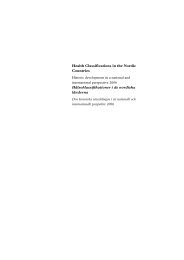- Page 1: NOMESCO Classification of Surgical
- Page 4 and 5: NOMESCO Classification of Surgical
- Page 6 and 7: 6 PREFACE Preface to first edition
- Page 8 and 9: Structure and classification guidel
- Page 10 and 11: 10 CONTENTS Chapter H Mammary gland
- Page 12 and 13: 12 CONTENTS TK Minor surgical proce
- Page 14 and 15: The procedure codes are independent
- Page 18 and 19: Matrix codes of chapters A, N and T
- Page 20 and 21: 20 STRUCTURE AN D CLASSIFICATION GU
- Page 22 and 23: 22 N ERVOUS SYSTEM CHAPTER A Nervou
- Page 24 and 25: 24 N ERVOUS SYSTEM AAF Shunt operat
- Page 26 and 27: 26 N ERVOUS SYSTEM AAU Removal of i
- Page 28 and 29: 28 N ERVOUS SYSTEM AC Peripheral ne
- Page 30 and 31: 30 N ERVOUS SYSTEM AWE Reoperation
- Page 32 and 33: BB Parathyroid glands BBA Parathyro
- Page 34 and 35: 34 EYE AND ADJACENT STRUCTURES CHAP
- Page 36 and 37: CBC Operations on eyelid for injury
- Page 38 and 39: CCA 20 Incision of lacrimal punctum
- Page 40 and 41: CEE Fixation of extraocular muscle
- Page 42 and 43: 42 EYE AND ADJACENT STRUCTURES CGF
- Page 44 and 45: 44 EYE AND ADJACENT STRUCTURES CHW
- Page 46 and 47: 46 EYE AND ADJACENT STRUCTURES CK C
- Page 48 and 49: 48 EYE AND ADJACENT STRUCTURES CW R
- Page 50 and 51: DA Auricle DAA 00 Incision of auric
- Page 52 and 53: DFD 20 Closure of rupture of round
- Page 54 and 55: 54 EAR, NOSE AND LARYNX DMB 00 Endo
- Page 56 and 57: 56 EAR, NOSE AND LARYNX DWC Reopera
- Page 58 and 59: EAB Reconstructive operations on li
- Page 60 and 61: EDB Excision of mandible Excision o
- Page 62 and 63: 62 TEETH, JAWS, MOUTH AND PHARYNX E
- Page 64 and 65: 64 TEETH, JAWS, MOUTH AND PHARYNX E
- Page 66 and 67:
EM Tonsils and adenoids 66 TEETH, J
- Page 68 and 69:
68 TEETH, JAWS, MOUTH AND PHARYNX E
- Page 70 and 71:
FA Major thoracic veins ASD = Atria
- Page 72 and 73:
72 HEART AND MAJOR THORACIC VESSELS
- Page 74 and 75:
74 HEART AND MAJOR THORACIC VESSELS
- Page 76 and 77:
76 HEART AND MAJOR THORACIC VESSELS
- Page 78 and 79:
78 HEART AND MAJOR THORACIC VESSELS
- Page 80 and 81:
80 HEART AND MAJOR THORACIC VESSELS
- Page 82 and 83:
FGB Repair of Ebstein’s anomaly 8
- Page 84 and 85:
FHF Repair of pulmonary atresia 84
- Page 86 and 87:
86 HEART AND MAJOR THORACIC VESSELS
- Page 88 and 89:
88 HEART AND MAJOR THORACIC VESSELS
- Page 90 and 91:
90 HEART AND MAJOR THORACIC VESSELS
- Page 92 and 93:
92 HEART AND MAJOR THORACIC VESSELS
- Page 94 and 95:
94 HEART AND MAJOR THORACIC VESSELS
- Page 96 and 97:
96 HEART AND MAJOR THORACIC VESSELS
- Page 98 and 99:
98 CHEST WALL, PLEURA, MEDIASTINUM,
- Page 100 and 101:
100 CHEST WALL, PLEURA, MEDIASTINUM
- Page 102 and 103:
102 CHEST WALL, PLEURA, MEDIASTINUM
- Page 104 and 105:
104 CHEST WALL, PLEURA, MEDIASTINUM
- Page 106 and 107:
106 CHEST WALL, PLEURA, MEDIASTINUM
- Page 108 and 109:
HAD Plastic operations on breast 10
- Page 110 and 111:
110 DIGESTIVE SYSTEM AN D SPLEEN CH
- Page 112 and 113:
112 DIGESTIVE SYSTEM AN D SPLEEN JA
- Page 114 and 115:
114 DIGESTIVE SYSTEM AN D SPLEEN JA
- Page 116 and 117:
116 DIGESTIVE SYSTEM AN D SPLEEN JB
- Page 118 and 119:
118 DIGESTIVE SYSTEM AN D SPLEEN JC
- Page 120 and 121:
JDC Partial gastrectomy 120 DIGESTI
- Page 122 and 123:
122 DIGESTIVE SYSTEM AN D SPLEEN JD
- Page 124 and 125:
124 DIGESTIVE SYSTEM AN D SPLEEN JF
- Page 126 and 127:
JFD Intestinal bypass operations 12
- Page 128 and 129:
JFH Total colectomy 128 DIGESTIVE S
- Page 130 and 131:
130 DIGESTIVE SYSTEM AN D SPLEEN JG
- Page 132 and 133:
132 DIGESTIVE SYSTEM AN D SPLEEN JG
- Page 134 and 135:
134 DIGESTIVE SYSTEM AN D SPLEEN JH
- Page 136 and 137:
136 DIGESTIVE SYSTEM AN D SPLEEN JK
- Page 138 and 139:
138 DIGESTIVE SYSTEM AN D SPLEEN JK
- Page 140 and 141:
140 DIGESTIVE SYSTEM AN D SPLEEN JL
- Page 142 and 143:
142 DIGESTIVE SYSTEM AN D SPLEEN JW
- Page 144 and 145:
144 URIN ARY SYSTEM, MALE GENITAL O
- Page 146 and 147:
146 URIN ARY SYSTEM, MALE GENITAL O
- Page 148 and 149:
148 URIN ARY SYSTEM, MALE GENITAL O
- Page 150 and 151:
150 URIN ARY SYSTEM, MALE GENITAL O
- Page 152 and 153:
152 URIN ARY SYSTEM, MALE GENITAL O
- Page 154 and 155:
154 URIN ARY SYSTEM, MALE GENITAL O
- Page 156 and 157:
156 URIN ARY SYSTEM, MALE GENITAL O
- Page 158 and 159:
158 URIN ARY SYSTEM, MALE GENITAL O
- Page 160 and 161:
160 FEMALE GENITAL ORGANS CHAPTER L
- Page 162 and 163:
162 FEMALE GENITAL ORGANS LAC Excis
- Page 164 and 165:
LBE Total excision of Fallopian tub
- Page 166 and 167:
LCC Partial excision of uterus 166
- Page 168 and 169:
168 FEMALE GENITAL ORGANS LDB Excis
- Page 170 and 171:
170 FEMALE GENITAL ORGANS LEG Vagin
- Page 172 and 173:
172 FEMALE GENITAL ORGANS LWC Reope
- Page 174 and 175:
174 OBSTETRIC PROCEDURES MA Procedu
- Page 176 and 177:
176 OBSTETRIC PROCEDURES MB Procedu
- Page 178 and 179:
178 OBSTETRIC PROCEDURES MWE Reoper
- Page 180 and 181:
NA Spine and neck NAA Exploratory p
- Page 182 and 183:
182 MUSCULOSKELETAL SYSTEM NAH Misc
- Page 184 and 185:
NAN Transplantation in spine 184 MU
- Page 186 and 187:
186 MUSCULOSKELETAL SYSTEM NAU 2y R
- Page 188 and 189:
188 MUSCULOSKELETAL SYSTEM NBE Oper
- Page 190 and 191:
190 MUSCULOSKELETAL SYSTEM NBK Oper
- Page 192 and 193:
192 MUSCULOSKELETAL SYSTEM NBS Oper
- Page 194 and 195:
194 MUSCULOSKELETAL SYSTEM NCB 0y P
- Page 196 and 197:
196 MUSCULOSKELETAL SYSTEM NCJ Frac
- Page 198 and 199:
198 MUSCULOSKELETAL SYSTEM NCN Tran
- Page 200 and 201:
ND Wrist and hand 200 MUSCULOSKELET
- Page 202 and 203:
202 MUSCULOSKELETAL SYSTEM NDG Exci
- Page 204 and 205:
204 MUSCULOSKELETAL SYSTEM NDL 09 F
- Page 206 and 207:
206 MUSCULOSKELETAL SYSTEM NDT Misc
- Page 208 and 209:
208 MUSCULOSKELETAL SYSTEM NEH Misc
- Page 210 and 211:
210 MUSCULOSKELETAL SYSTEM NET 49 C
- Page 212 and 213:
212 MUSCULOSKELETAL SYSTEM NFE Oper
- Page 214 and 215:
214 MUSCULOSKELETAL SYSTEM NFL Oper
- Page 216 and 217:
216 MUSCULOSKELETAL SYSTEM NFW 79 R
- Page 218 and 219:
218 MUSCULOSKELETAL SYSTEM NGE 09 I
- Page 220 and 221:
220 MUSCULOSKELETAL SYSTEM NGK 59 A
- Page 222 and 223:
222 MUSCULOSKELETAL SYSTEM NGU 49 R
- Page 224 and 225:
224 MUSCULOSKELETAL SYSTEM NHE Oper
- Page 226 and 227:
226 MUSCULOSKELETAL SYSTEM NHK Oper
- Page 228 and 229:
228 MUSCULOSKELETAL SYSTEM NHR Oper
- Page 230 and 231:
230 PERIPHERAL VESSELS AN D LYMPHAT
- Page 232 and 233:
232 PERIPHERAL VESSELS AN D LYMPHAT
- Page 234 and 235:
234 PERIPHERAL VESSELS AN D LYMPHAT
- Page 236 and 237:
236 PERIPHERAL VESSELS AN D LYMPHAT
- Page 238 and 239:
238 PERIPHERAL VESSELS AN D LYMPHAT
- Page 240 and 241:
240 PERIPHERAL VESSELS AN D LYMPHAT
- Page 242 and 243:
242 PERIPHERAL VESSELS AN D LYMPHAT
- Page 244 and 245:
244 PERIPHERAL VESSELS AN D LYMPHAT
- Page 246 and 247:
PH Operations on veins PHB Ligature
- Page 248 and 249:
248 PERIPHERAL VESSELS AN D LYMPHAT
- Page 250 and 251:
250 PERIPHERAL VESSELS AN D LYMPHAT
- Page 252 and 253:
252 SKIN QAA 10 Incision of skin of
- Page 254 and 255:
254 SKIN QBB Procedures for wounds
- Page 256 and 257:
256 SKIN QCE Excision and repair of
- Page 258 and 259:
QDH Operations on toe nails QDH 00
- Page 260 and 261:
260 SKIN QWD Reoperation for haemor
- Page 262 and 263:
TCB 20 Therapeutic injection into e
- Page 264 and 265:
264 TRANSLUMINAL ENDOSCOPY TG Minor
- Page 266 and 267:
266 TRANSLUMINAL ENDOSCOPY TL Minor
- Page 268 and 269:
268 TRANSLUMINAL ENDOSCOPY CHAPTER
- Page 270 and 271:
UJD Gastroscopy 270 TRANSLUMINAL EN
- Page 272 and 273:
272 TRANSLUMINAL ENDOSCOPY UK Trans
- Page 274 and 275:
274 INVESTIGATIVE PROCEDURES CONNEC
- Page 276 and 277:
276 PROCUREMENT OF ORGANS OR TISSUE
- Page 278 and 279:
278 PROCUREMENT OF ORGANS OR TISSUE
- Page 280 and 281:
280 GENERAL QUALIFIERS PERTAINING T
- Page 282 and 283:
282 GENERAL QUALIFIERS PERTAINING T
- Page 284 and 285:
284 GENERAL QUALIFIERS PERTAINING T
- Page 286 and 287:
286 GENERAL QUALIFIERS PERTAINING T
- Page 288 and 289:
288 APPENDIX 1 APPENDIX 1 Classific
- Page 290 and 291:
Pcy 10 Suprarenal or juxtarenal abd
- Page 292 and 293:
Page No. NCSP 1.14 292 APPENDIX 2 A
- Page 294 and 295:
294 NOMESCO PUBLICATIONS NOMESCO pu









